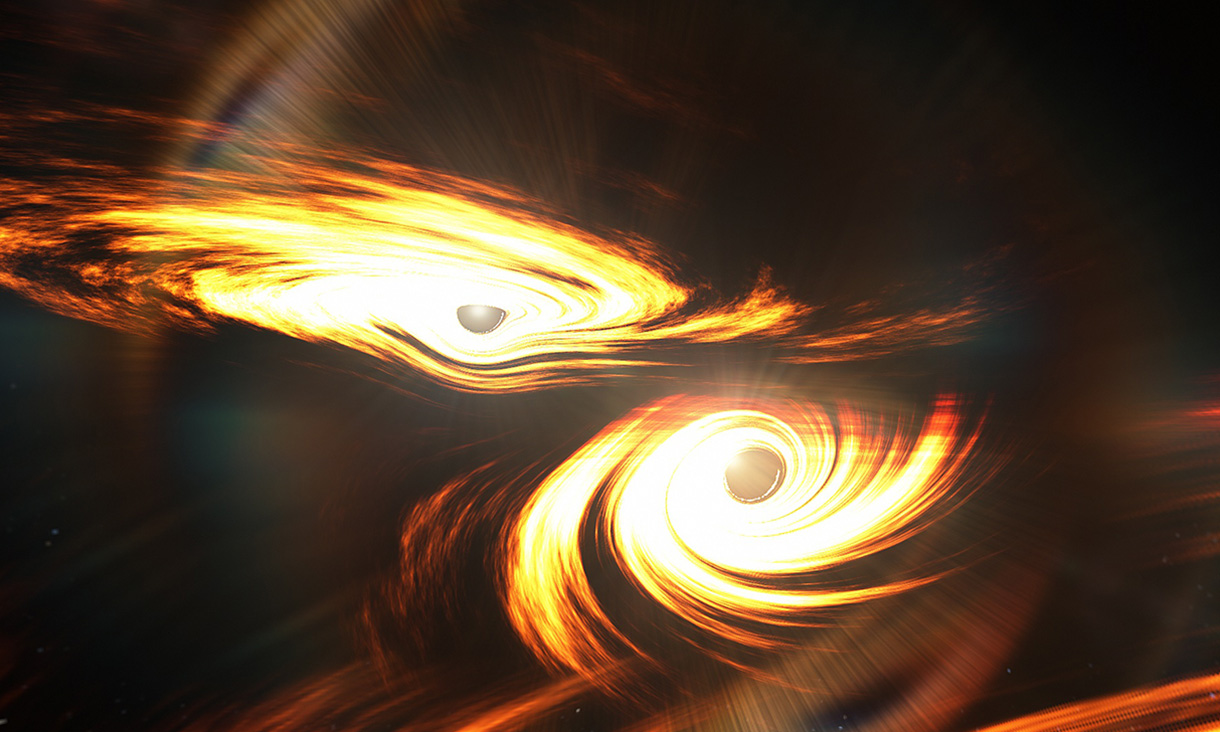First ever detection of monster black hole collision

Artist’s impression of binary black holes about to collide. Image credit: Mark Myers, ARC Centre of Excellence for Gravitational Wave Discovery (OzGrav).
In summary
- Astronomers have reported the first-ever direct observation of the most massive black hole merger to date
- Two monster black holes collided to form an intermediate-mass black hole, about 150 times as heavy as the Sun
Astronomers from the LIGO and Virgo Scientific Collaboration (LVC) have reported the first ever direct observation of the most massive black hole merger to date.
Two monster black holes collided to form an even more massive object—an intermediate-mass black hole, about 150 times as heavy as the Sun.
Researchers from the ARC Centre of Excellence for Gravitational Wave Discovery (OzGrav) contributed to the detection and used the computing resources of the new Gravitational-Wave Data Centre to infer the masses of the merging black holes.
The online detection team at the University of Western Australia detected the event, GW190521, seconds after the gravitational-wave data were available, and helped generate public alerts for the LIGO Scientific Collaboration.
How are black holes formed?
The rare event has prompted researchers to question how the black hole formed, its origins and how the two black holes found each other in the first place.
OzGrav postdoctoral researcher at Swinburne and LVC member Dr Simon Stevenson says: “These ‘impossibly’ massive black holes may be made of two smaller black holes which previously merged. If true, we have a big black hole made of smaller black holes, with even smaller black holes inside them—like Russian Dolls.”
Since gravitational waves directly measure the masses of the colliding black holes, this measurement should be much more robust than the similar mass black hole previously reported by Liu et al (published in the journal Nature last year).
That measurement was based on an interpretation of the spectrum of light from the Galactic star system LB-1, which has since been refuted. Based on the current study’s mass measurements, researchers found that this kind of black hole couldn’t have formed from a collapsing star – instead, it may have formed from a previous black hole collision.

“We are witnessing the birth of an intermediate mass black hole: a black hole more than 100 times as heavy as the Sun, almost twice as heavy as any black hole previously observed with gravitational-waves,” Dr Stevenson says. “These intermediate mass black holes could be the seeds that grow into the supermassive black holes that reside in the centres of galaxies.”
These gravitational waves came from over 15 billion light years away! But isn't the Universe only around 14 billion years old, you ask? It turns out that the Universe was actually around 7 billion years old when these two black holes collided. As the gravitational waves rippled out through the Universe, the Universe was expanding.
Consequently, the measured distance to this collision is now further than the product of the speed of light and the time travelled—mind (and space) bending stuff! This shows gravitational waves can probe the ancient history of the Universe, when galaxies were forming stars at a rate around 10 times higher than the present day.
-
Media Enquiries
Related articles
-

- Astronomy
High school students work with Swinburne astronomers on the future of space
Swinburne’s Youth Space Innovation Challenge has inspired over 330 Australian teenagers to pursue a career in STEM.
Friday 26 July 2024 -

- Astronomy
- Science
Swinburne appoints new Director of Innovative Planet Research Institute
Leading geodesy expert, Professor Allison Kealy, has been appointed as the inaugural Director of Swinburne University's Innovative Planet Research Institute.
Monday 22 April 2024 -

- Astronomy
- University
OzGrav 2.0: A ‘new era of astrophysics’ launched at Swinburne
The next phase in the world-leading ARC Centre of Excellence for Gravitational Wave Discovery, dubbed 'OzGrav 2.0', launched this week at Swinburne University of Technology.
Wednesday 17 April 2024 -

- Design
- Astronomy
- Technology
- University
Swinburne ‘Rock Muncher’ takes part in Australian Rover Challenge
A multidisciplinary student team from Swinburne University of Technology competed in the 2024 Australian Rover Challenge held in Adelaide, South Australia.
Thursday 11 April 2024 -
.jpeg/_jcr_content/renditions/cq5dam.web.256.144.jpeg)
- Astronomy
New JWST observations reveal black holes rapidly shut off star formation in massive galaxies
New research showcases new observations from the James Webb Space Telescope that suggest black holes rapidly shut off star-formation in massive galaxies by explosively removing large amounts of gas...
Tuesday 23 April 2024

